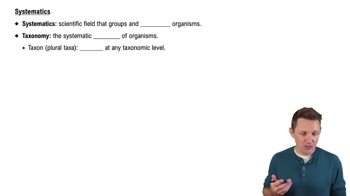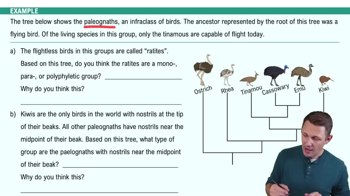Table of contents
- 1. Introduction to Biology2h 42m
- 2. Chemistry3h 40m
- 3. Water1h 26m
- 4. Biomolecules2h 23m
- 5. Cell Components2h 26m
- 6. The Membrane2h 31m
- 7. Energy and Metabolism2h 0m
- 8. Respiration2h 40m
- 9. Photosynthesis2h 49m
- 10. Cell Signaling59m
- 11. Cell Division2h 47m
- 12. Meiosis2h 0m
- 13. Mendelian Genetics4h 44m
- Introduction to Mendel's Experiments7m
- Genotype vs. Phenotype17m
- Punnett Squares13m
- Mendel's Experiments26m
- Mendel's Laws18m
- Monohybrid Crosses19m
- Test Crosses14m
- Dihybrid Crosses20m
- Punnett Square Probability26m
- Incomplete Dominance vs. Codominance20m
- Epistasis7m
- Non-Mendelian Genetics12m
- Pedigrees6m
- Autosomal Inheritance21m
- Sex-Linked Inheritance43m
- X-Inactivation9m
- 14. DNA Synthesis2h 27m
- 15. Gene Expression3h 20m
- 16. Regulation of Expression3h 31m
- Introduction to Regulation of Gene Expression13m
- Prokaryotic Gene Regulation via Operons27m
- The Lac Operon21m
- Glucose's Impact on Lac Operon25m
- The Trp Operon20m
- Review of the Lac Operon & Trp Operon11m
- Introduction to Eukaryotic Gene Regulation9m
- Eukaryotic Chromatin Modifications16m
- Eukaryotic Transcriptional Control22m
- Eukaryotic Post-Transcriptional Regulation28m
- Eukaryotic Post-Translational Regulation13m
- 17. Viruses37m
- 18. Biotechnology2h 58m
- 19. Genomics17m
- 20. Development1h 5m
- 21. Evolution3h 1m
- 22. Evolution of Populations3h 53m
- 23. Speciation1h 37m
- 24. History of Life on Earth2h 6m
- 25. Phylogeny2h 31m
- 26. Prokaryotes4h 59m
- 27. Protists1h 12m
- 28. Plants1h 22m
- 29. Fungi36m
- 30. Overview of Animals34m
- 31. Invertebrates1h 2m
- 32. Vertebrates50m
- 33. Plant Anatomy1h 3m
- 34. Vascular Plant Transport1h 2m
- 35. Soil37m
- 36. Plant Reproduction47m
- 37. Plant Sensation and Response1h 9m
- 38. Animal Form and Function1h 19m
- 39. Digestive System1h 10m
- 40. Circulatory System1h 49m
- 41. Immune System1h 12m
- 42. Osmoregulation and Excretion50m
- 43. Endocrine System1h 4m
- 44. Animal Reproduction1h 2m
- 45. Nervous System1h 55m
- 46. Sensory Systems46m
- 47. Muscle Systems23m
- 48. Ecology3h 11m
- Introduction to Ecology20m
- Biogeography14m
- Earth's Climate Patterns50m
- Introduction to Terrestrial Biomes10m
- Terrestrial Biomes: Near Equator13m
- Terrestrial Biomes: Temperate Regions10m
- Terrestrial Biomes: Northern Regions15m
- Introduction to Aquatic Biomes27m
- Freshwater Aquatic Biomes14m
- Marine Aquatic Biomes13m
- 49. Animal Behavior28m
- 50. Population Ecology3h 41m
- Introduction to Population Ecology28m
- Population Sampling Methods23m
- Life History12m
- Population Demography17m
- Factors Limiting Population Growth14m
- Introduction to Population Growth Models22m
- Linear Population Growth6m
- Exponential Population Growth29m
- Logistic Population Growth32m
- r/K Selection10m
- The Human Population22m
- 51. Community Ecology2h 46m
- Introduction to Community Ecology2m
- Introduction to Community Interactions9m
- Community Interactions: Competition (-/-)38m
- Community Interactions: Exploitation (+/-)23m
- Community Interactions: Mutualism (+/+) & Commensalism (+/0)9m
- Community Structure35m
- Community Dynamics26m
- Geographic Impact on Communities21m
- 52. Ecosystems2h 36m
- 53. Conservation Biology24m
25. Phylogeny
Phylogeny
Problem 2
Textbook Question
Fill in this concept map about systematics.

 Verified step by step guidance
Verified step by step guidance1
Step 1: Start by identifying the main concept, 'Systematics,' which is the study of evolutionary relationships among organisms.
Step 2: For box (a), recognize that evolutionary history is called 'phylogeny,' which traces the lineage and relationships of organisms.
Step 3: For box (b), evolutionary history is based on 'morphological and molecular data,' which includes physical traits and genetic information.
Step 4: For box (c), the images of limbs represent 'homologous structures,' which are anatomical features shared due to common ancestry.
Step 5: For box (e), evolutionary relationships are shown in 'phylogenetic trees,' which visually represent hypotheses about the evolutionary connections among species.
 Verified video answer for a similar problem:
Verified video answer for a similar problem:This video solution was recommended by our tutors as helpful for the problem above
Video duration:
2mPlay a video:
Was this helpful?
Key Concepts
Here are the essential concepts you must grasp in order to answer the question correctly.
Systematics
Systematics is a branch of biology that deals with the classification and evolutionary relationships among organisms. It aims to understand the diversity of life by tracing the evolutionary history of species and generating hypotheses about their relationships. This field combines data from various sources, including morphology, genetics, and fossil records, to construct phylogenetic trees that illustrate these relationships.
Recommended video:

Systematics
Cladistics
Cladistics is a method within systematics that classifies organisms based on shared derived characteristics, known as synapomorphies. This approach emphasizes the importance of evolutionary lineage and aims to create a branching diagram, or cladogram, that reflects the evolutionary pathways of different species. Cladistics helps in identifying groups of organisms that share a common ancestor, thus providing insights into their evolutionary history.
Recommended video:

Cladistics Example 1
Phylogenetic Trees
Phylogenetic trees are graphical representations that depict the evolutionary relationships among various species or groups. They illustrate how species diverged from common ancestors over time, with branches representing lineages and nodes indicating points of divergence. These trees are constructed using data from morphological traits, genetic sequences, and fossil evidence, allowing scientists to visualize and analyze the evolutionary history of life on Earth.
Recommended video:

Building Phylogenetic Trees Example 2

 7:10m
7:10mWatch next
Master Reading a Phylogenetic Tree with a bite sized video explanation from Jason
Start learningRelated Videos
Related Practice
Multiple Choice
If you wanted to determine the lineage of plants that have evolved on a relatively young archipelago—approximately 15,000 years old—what type of nucleic acid should you compare?
1041
views
